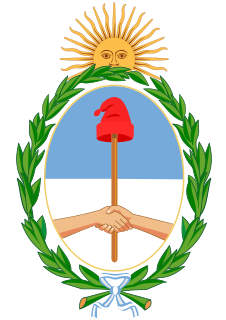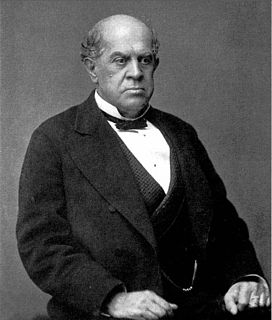
Domingo Faustino Sarmiento was an Argentine activist, intellectual, writer, statesman and the seventh President of Argentina. His writing spanned a wide range of genres and topics, from journalism to autobiography, to political philosophy and history. He was a member of a group of intellectuals, known as the Generation of 1837, who had a great influence on nineteenth-century Argentina. He was particularly concerned with educational issues and was also an important influence on the region's literature.

Pedro Sarmiento de Gamboa (1532–1592) was a Spanish explorer, author, historian, mathematician, astronomer, and scientist. His birthplace is not certain and may have been Pontevedra, in Galicia, where his paternal family originated, or Alcalá de Henares in Castile, where he later is known to have studied. His father Bartolomé Sarmiento was born in Pontevedra and his mother María Gamboa was born in Bilbao, Basque Country.

Facundo: Civilization and Barbarism is a book written in 1845 by Domingo Faustino Sarmiento, a writer and journalist who became the seventh president of Argentina. It is a cornerstone of Latin American literature: a work of creative non-fiction that helped to define the parameters for thinking about the region's development, modernization, power, and culture. Subtitled Civilization and Barbarism, Facundo contrasts civilization and barbarism as seen in early 19th-century Argentina. Literary critic Roberto González Echevarría calls the work "the most important book written by a Latin American in any discipline or genre".
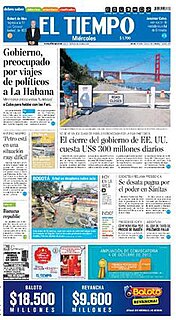
El Tiempo is a nationally distributed broadsheet daily newspaper in Colombia. As of 2012, it had the highest circulation in Colombia with an average daily weekday of 1,137,483 readers, rising to 1,921,571 readers for the Sunday edition. After longtime rival El Espectador was reduced to a weekly publication following an internal financial crisis in 2001, El Tiempo enjoyed monopoly status in Colombian media as the only daily that circulated nationally, as most smaller dailies have limited distribution outside their own regions. However, El Espectador returned to the daily format on May 11, 2008.
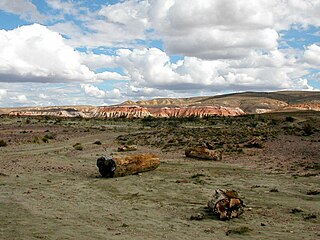
Sarmiento is a town in the province of Chubut, Argentina. It has about 8,000 inhabitants as per the 2001 census [INDEC], and is the head town of the department of the same name. It is located on the so-called Central Corridor of Patagonia, in a fertile valley amidst an otherwise arid region, 140 km west from Comodoro Rivadavia, in the south of Chubut. It sits between two lakes, Lake Musters and Lake Colhue Huapi. Notable attractions are the Petrified Forest and caves with Aborigine hand paintings.

Club Atlético Sarmiento is a football club from the city of Junín, Buenos Aires Province, Argentina. The squad currently plays in the Primera B Nacional, the second division of the Argentine football league system, recently relegated from the Argentine Primera División.

Capitán Sarmiento Partido is a partido of Buenos Aires Province in Argentina.
Club Atlético Sarmiento is an Argentine sports club based in the city of Resistencia in Chaco Province. Although many sports are hosted at the club, Sarmiento is mostly known for its football team, which currently plays in Torneo Argentino B, the regionalised fourth level of the Argentine football league system.

The National University of San Juan is a public university in Argentina. Its seat is located in the city of San Juan, capital of the province of the same name, in the Cuyo region. It was founded in 1973, based on several local institutions and a faculty of the National University of Cuyo.

Cómbita is a town and municipality in the Colombian Department of Boyacá, part of the subregion of the Central Boyacá Province. Cómbita is situated on the Altiplano Cundiboyacense and borders Arcabuco and the department of Santander in the north, Sotaquirá in the northeast, Tuta and Oicatá in the east, department capital Tunja at 8.5 kilometres (5.3 mi) away and Motavita in the south and Arcabuco and Motavita in the west.

Sarmiento is a department located in the south west of San Juan Province in Argentina.
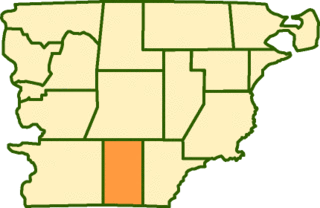
Sarmiento Department is a department of Chubut Province in Argentina.

The Sarmiento line is a broad gauge commuter rail service in Buenos Aires Province, Argentina, run by the state-owned Trenes Argentinos since 11 Sep 2013.
Brian Óscar Sarmiento is an Argentine professional footballer who plays for Newell's Old Boys as a forward.
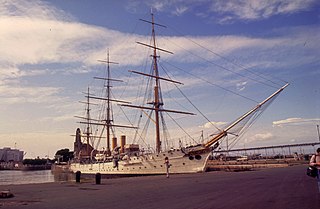
ARA Presidente Sarmiento is a museum ship in Argentina, originally built as a training ship for the Argentine Navy and named after Domingo Faustino Sarmiento, the seventh President of Argentina. She is considered to be the last intact cruising training ship from the 1890s.

Martín Sarmiento or Martiño Sarmiento, also Father Sarmiento, was a Spanish scholar, writer and Benedictine monk, illustrious representative of the Enlightenment.
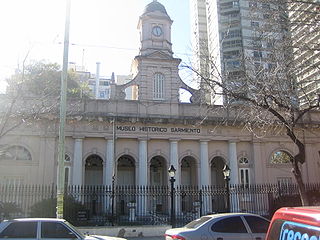
The Museo Histórico Sarmiento Sarmiento History Museum, located in the Buenos Aires neighborhood of Belgrano, is a museum dedicated to Argentine history, and in particular to the Generation of '80 and the life of President Domingo Faustino Sarmiento, a writer and political figure who was President of Argentina between 1868 and 1874. There are also sections that show the literary works of Nicolás Avellaneda, his presidential successor and about the revolution caused by the federalization of Buenos Aires in 1880, when the national government had to abandon its location in downtown Buenos Aires and move to the building where the museum is today in Belgrano, then the outskirts of the city.

Avenida General Sarmiento is an avenue located in the Palermo neighborhood, in Buenos Aires, Argentina. It runs from Plaza Italia to the Costanera Rafael Obligado Avenue, across the Parque Tres de Febrero.


